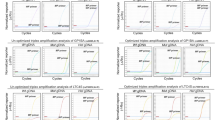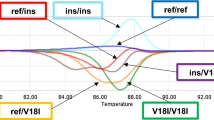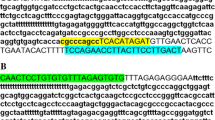Abstract
DNA genotyping is important for epidemiological and clinical studies and diagnosis for individuals. Genotyping error can strongly influence the outcome of such investigations. One possible reason for genotyping error is additional DNA sequence variation, which can lead to allelic dropout. Based on a published study where allelic dropout occurred in genotyping the cholesteryl ester transfer protein TaqIB polymorphism by a TaqMan-based method, we investigated the susceptibility of the single-base extension (SBE)-based GenoSNIP method to additional sequence variation at the primer attachment site. SBE genotyping was applied to 147 patient samples with known alleles and to synthetic SBE templates. Variables were positions of nucleotide mismatches, yield of SBE reactions, primer design, and ratio of alleles in the template. No allelic dropout occurred when genotyping the TaqIB polymorphism regardless of the reported nucleotide mismatch. Yields of SBE assays critical for allelic dropout were decreased in the presence of the reported nucleotide mismatch depending on SBE assay design. In a systematic mutation scan, only the position immediately adjacent to the polymorphism caused allelic dropout under standard conditions. Depending on SBE assay design, changes in allelic ratio due to a nucleotide mismatch were similar in appearance to changes due to sample mixture or copy number variation. In conclusion, we found the SBE genotyping assays to be relatively robust against interfering DNA variations. The importance of appropriate design and validation of assays, especially in regard to critical yields and potentially interfering nucleotide mismatches, should be emphasized particularly in clinical settings. Care should be taken when interpreting observed changes in the allelic ratio, which could be caused by nucleotide mismatches, sample mixtures, or copy number variation.





Similar content being viewed by others
References
Pompanon F, Bonin A, Bellemain E, Taberlet P (2005) Genotyping errors: causes, consequences and solutions. Nat Rev Genet 6:847–859
Walters K (2005) The effect of genotyping error in sib-pair genomewide linkage scans depends crucially upon the method of analysis. J Hum Genet 50:329–337
Sobel E, Papp JC, Lange K (2002) Detection and integration of genotyping errors in statistical genetics. Am J Hum Genet 70:496–508
Bonin A, Bellemain E, Bronken EP, Pompanon F, Brochmann C, Taberlet P (2004) How to track and assess genotyping errors in population genetics studies. Mol Ecol 13:3261–3273
Fredman D, White SJ, Potter S, Eichler EE, Den Dunnen JT, Brookes AJ (2004) Complex SNP-related sequence variation in segmental genome duplications. Nat Genet 36:861–866
Collins FS, Brooks LD, Chakravarti A (1998) A DNA polymorphism discovery resource for research on human genetic variation. Genome Res 8:1229–1231
Teupser D, Rupprecht W, Lohse P, Thiery J (2001) Fluorescence-based detection of the CETP TaqIB polymorphism: false positives with the TaqMan-based exonuclease assay attributable to a previously unknown gene variant. Clin Chem 47:852–857
Freedman ML, Penney KL, Stram DO, Riley S, McKean-Cowdin R, Le Marchand L, Altshuler D, Haiman CA (2005) A haplotype-based case-control study of BRCA1 and sporadic breast cancer risk. Cancer Res 65:7516–7522
von Ahsen N, Oellerich M, Armstrong VW, Schutz E (1999) Application of a thermodynamic nearest-neighbor model to estimate nucleic acid stability and optimize probe design: prediction of melting points of multiple mutations of apolipoprotein B-3500 and factor V with a hybridization probe genotyping assay on the LightCycler. Clin Chem 45:2094–2101
Phillips M, Meadows CA, Huang MY, Millson A, Lyon E (2000) Simultaneous detection of C282Y and H63D hemochromatosis mutations by dual-color probes. Mol Diagn 5:107–116
Bernard PS, Ajioka RS, Kushner JP, Wittwer CT (1998) Homogeneous multiplex genotyping of hemochromatosis mutations with fluorescent hybridization probes. Am J Pathol 153:1055–1061
Warshawsky I, Hren C, Sercia L, Shadrach B, Deitcher SR, Newton E, Kottke-Marchant K (2002) Detection of a novel point mutation of the prothrombin gene at position 20209. Diagn Mol Pathol 11:152–156
Lyondagger E, Millsondagger A, Phan T, Wittwer CT (1998) Detection and identification of base alterations within the region of factor V Leiden by fluorescent melting curves. Mol Diagn 3:203–209
Erali M, Schmidt B, Lyon E, Wittwer C (2003) Evaluation of electronic microarrays for genotyping factor V, factor II, and MTHFR. Clin Chem 49:732–739
Hawkins JR, Khripin Y, Valdes AM, Weaver TA (2002) Miniaturized sealed-tube allele-specific PCR. Human Mutat 19:543–553
Liebman HA, Sutherland D, Bacon R, McGehee W (1996) Evaluation of a tissue factor dependent factor V assay to detect factor V Leiden: demonstration of high sensitivity and specificity for a generally applicable assay for activated protein C resistance. Br J Haematol 95:550–553
Wenzel T, Elssner T, Fahr K, Bimmler J, Richter S, Thomas I, Kostrzewa M (2003) Genosnip: SNP genotyping by MALDI-TOF MS using photocleavable oligonucleotides. Nucleosides Nucleotides Nucleic Acids 22:1579–1581
Boekholdt SM, Sacks FM, Jukema JW, Shepherd J, Freeman DJ, McMahon AD, Cambien F, Nicaud V, de Grooth GJ, Talmud PJ, Humphries SE, Miller GJ, Eiriksdottir G, Gudnason V, Kauma H, Kakko S, Savolainen MJ, Arca M, Montali A, Liu S, Lanz HJ, Zwinderman AH, Kuivenhoven JA, Kastelein JJ (2005) Cholesteryl ester transfer protein TaqIB variant, high-density lipoprotein cholesterol levels, cardiovascular risk, and efficacy of pravastatin treatment: individual patient meta-analysis of 13,677 subjects. Circulation 111:278–287
Carlquist JF, Muhlestein JB, Horne BD, Hart NI, Bair TL, Molhuizen HO, Anderson JL (2003) The cholesteryl ester transfer protein Taq1B gene polymorphism predicts clinical benefit of statin therapy in patients with significant coronary artery disease. Am Heart J 146:1007–1014
Ayyadevara S, Thaden JJ, Shmookler Reis RJ (2000) Discrimination of primer 3′-nucleotide mismatch by taq DNA polymerase during polymerase chain reaction. Anal Biochem 284:11–18
Li Y, Korolev S, Waksman G (1998) Crystal structures of open and closed forms of binary and ternary complexes of the large fragment of Thermus aquaticus DNA polymerase I: structural basis for nucleotide incorporation. EMBO J 17:7514–7525
Margraf RL, Mao R, Wittwer CT (2006) Masking selected sequence variation by incorporating mismatches into melting analysis probes. Human Mutat 27:269–278
Lyon E (2005) Discovering rare variants by use of melting temperature shifts seen in melting curve analysis. Clin Chem 51:1331–1332
Acknowledgment
We are grateful to Steffen Dienst for writing statistical software, Wiebke Strehlitz and Vera Zebisch for initial studies, and Sonya Faber and the anonymous reviewers for helpful comments. This project was supported by grant no. 7692/1187 from the Saechsische Aufbaubank–Foerderbank, by grant no. 4212/04-04 from the European Fund for Regional Development (EFRE), and by the Hochschul- und Wissenschaftsprogramm of the German Federal Ministry for Education and Research.
Author information
Authors and Affiliations
Corresponding author
Rights and permissions
About this article
Cite this article
Kirsten, H., Teupser, D., Weissfuss, J. et al. Robustness of single-base extension against mismatches at the site of primer attachment in a clinical assay. J Mol Med 85, 361–369 (2007). https://doi.org/10.1007/s00109-006-0129-2
Received:
Accepted:
Published:
Issue Date:
DOI: https://doi.org/10.1007/s00109-006-0129-2




